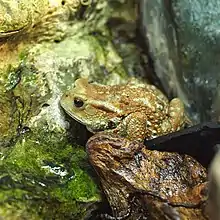Miyako toad
The Miyako toad (Bufo gargarizans miyakonis) is a subspecies of the Asiatic toad that is native to the Miyako Islands, in the Ryūkyū Islands of Japan.[4]
| Miyako toad | |
|---|---|
 | |
| Scientific classification | |
| Domain: | Eukaryota |
| Kingdom: | Animalia |
| Phylum: | Chordata |
| Class: | Amphibia |
| Order: | Anura |
| Family: | Bufonidae |
| Genus: | Bufo |
| Species: | |
| Subspecies: | B. g. miyakonis |
| Trinomial name | |
| Bufo gargarizans miyakonis | |
| Synonyms | |
|
Bufo bufo miyakonis (protonym)[1] | |
Taxonomy
In 1927, Japanese zoologist Okada Yaichirō included Bufo bufo miyakonis (Schlegel) in a study of the country's "tailless batrachians"; however, no further details were provided, making this a nomen nudum.[3]: 220 The Miyako toad was first described, as Bufo bufo miyakonis, i.e., as a subspecies of the Common toad, by Okada in 1931, with Miyako-jima in the Ryūkyū Islands given as the type locality.[1][5] In 1947, Inger, arguing that Okada did not sufficiently distinguish his new subspecies from the Asiatic toad of China, treated this name as a synonym of Bufo bufo gargarizans.[6]: 321 In 1980, Kawamura Toshijirō et al., based on laboratory crosses, recommended the toad be treated as a subspecies of the Japanese common toad, as Bufo japonicus miyakonis.[2]: 123 In 1984, Matsui Masafumi concluded the Miyako toad was a subspecies of the Asiatic toad, i.e., Bufo gargarizans miyakonis.[3]: 417 [5] In its native Japan, the toad's vernacular name is Miyako hiki-gaeru (ミヤコヒキガエル).[4] Though sometimes thought to have been introduced, a Late Pleistocene fossil bufonid has been identified from Miyako-jima.[4][7][8]
Description
The Miyako toad is somewhat warty, but less so than the Japanese common toad.[9] It has a grey-brown to reddish-brown back with some paler spots and stripes, and a whitish belly with some black spots.[9] Males have a snout–vent length (SVL) of 61–113 millimetres (2.4–4.4 in), with a mean of 85 millimetres (3.3 in), while females are a little larger, at 77–119 millimetres (3.0–4.7 in), mean of 97 millimetres (3.8 in).[4] Its width is around 36% of its SVL, its hand and arm length, 44%, the length of its tibia, 35% in males and 33% in females, and its relatively flat parotoid gland, c. 17%.[4] Males have black nuptial pads.[4] There is no vocal sac.[4]
Distribution and habitat
The Miyako toad is native to Miyako-jima and Irabu-jima in the Miyako Islands, where it lives among the grasses and fields of sugarcane, but has also been introduced to Okinawa Island as well as Kitadaitō-jima and Minamidaitō-jima in the Daitō Islands.[4][10]
Ecology
The Miyako toad's diet largely comprises small invertebrates such as ants, beetles, snails, and worms.[4] The breeding season runs from September to March.[4] Its mating call includes five distinct notes, lasting in total some 1.5 seconds.[4] Females lay some twelve to fourteen thousand eggs, some 1.7–2.0 millimetres (0.067–0.079 in) in diameter.[4] The small dark tadpoles reach a length of around 30 millimetres (1.2 in); the SVL on metamorphosis, which occurs after March, is 11 millimetres (0.43 in).[4][9]
Conservation
The Miyako toad is classed as Near Threatened on the Ministry of the Environment Red List.[11]
See also
References
- Okada, Y. (1931). The Tailless Batrachians of the Japanese Empire. Tokyo: Imperial Agricultural Experiment Station. p. 47.
- Kawamura, T.; Nishioka, M.; Ueda, H. (1980). "Inter- and intraspecific hybrids among Japanese, European and American toads". Scientific report of the Laboratory for Amphibian Biology, Hiroshima University. 4: 1–125. doi:10.15027/333. ISSN 0386-3166.
- Matsui Masafumi [in French] (1984). "Morphometric variation analyses and revision of the Japanese toads (Genus Bufo, Bufonidae)". Contributions from the Biological Laboratory, Kyoto University. 26 (3–4): 209–428. hdl:2433/156031. ISSN 0452-9987.
- Matsui, Masafumi; Maeda, Norio, eds. (2018). 日本産カエル大鑑 [Encyclopaedia of Japanese Frogs] (in Japanese and English). Tokyo: Bun-Ichi Sogo Shuppan. p. 40–43. ISBN 978-4-8299-8843-5.
- "Bufo gargarizans Cantor, 1842". Amphibian Species of the World. Retrieved 11 May 2022.
- Inger, R.F. (8 December 1947). "Preliminary survey of the amphibians of the Riukiu Islands". Fieldiana: Zoology. 32 (5): 295–352. doi:10.5962/bhl.title.2991. ISSN 0015-0754.
- 新日本両生爬虫類図鑑 [Amphibians and Reptiles of Japan] (in Japanese). Herpetological Society of Japan. 2021. pp. 39–41. ISBN 978-4-88325-734-8.
- Nokariya, H; Hasegawa, Y. [in Japanese] (1985). "Fossil frogs from Pinza-Abu Cave, Miyako Island, Okinawa, Japan". ピンザアブ:ピンザアブ洞穴発掘調査報告 [Pinza-Abu: Reports on Excavation of the Pinza-Abu Cave] (in Japanese). Naha: Okinawa Prefectural Board of Education. pp. 151–159.
- Goris, Richard C.; Maeda, Norio (2004). Guide to the Amphibians and Reptiles of Japan. Malabar: Krieger Publishing Company. pp. 46–48. ISBN 1-57524-085-8.
- Ministry of the Environment, ed. (2014). レッドデータブック2014 —日本の絶滅のおそれのある野生生物— 3 爬虫類・両生類 [Red Data Book 2014 — Threatened Wildlife of Japan — Volume 3, Reptilia / Amphibia] (in Japanese). Gyōsei Corporation. p. 145. ISBN 978-4-324-09897-4.
- 両生類 [Amphibians] (in Japanese). Ministry of the Environment. 27 March 2020. Retrieved 11 May 2022.